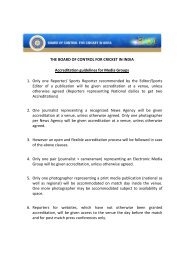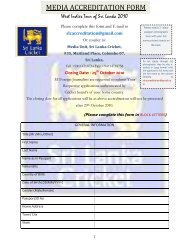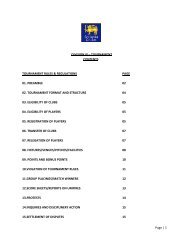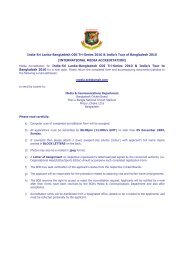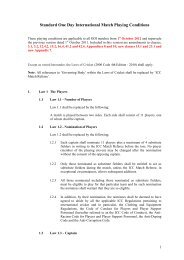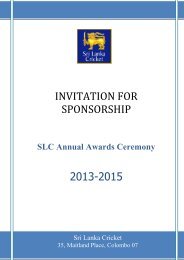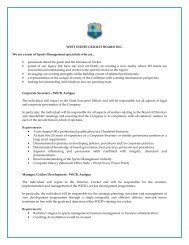Standard ODI Playing Conditions - Sri Lanka Cricket
Standard ODI Playing Conditions - Sri Lanka Cricket
Standard ODI Playing Conditions - Sri Lanka Cricket
Create successful ePaper yourself
Turn your PDF publications into a flip-book with our unique Google optimized e-Paper software.
04<br />
standard ONE-day INTERNatiONAL<br />
match playing conditions<br />
3 Caught Decisions<br />
The on-field umpire shall be entitled to refer an appeal for a caught decision to<br />
the third umpire in the following circumstances:<br />
3.1 Clean Catches<br />
a) Should the bowler’s end umpire be unable to decide whether or not a<br />
catch was taken cleanly, he shall first consult with the square leg umpire.<br />
b) Should both umpires be unable to make a decision, they may consult<br />
by two-way radio with the third umpire. Following such consultation,<br />
the final decision will be made and given by the bowler’s end umpire,<br />
who will take into account the on-field umpires’ initial views and any<br />
other advice received from the third umpire.<br />
c) the third umpire has to determine whether the batsman has been<br />
caught. However, when reviewing the television replay(s), if it is clear<br />
to the third umpire that the batsman did not hit the ball, he shall<br />
indicate that the batsman is not out. See also paragraph 6 below.<br />
d) the final decision shall be indicated in the normal fashion by the<br />
bowler’s end umpire.<br />
3.2 Bump Ball<br />
a) Should the bowler’s end umpire be unable to decide whether a catch<br />
was taken from a bump ball or not, he shall first consult with the<br />
square leg umpire.<br />
b) Should both on-field umpires be unable to make a decision, the<br />
bowler’s end umpire shall be entitled to refer the decision to the<br />
third umpire to review a TV replay(s) of the batsman’s stroke as in<br />
paragraph 2.2.<br />
c) the third umpire has to determine whether the ball was a bump ball<br />
or not. However, when reviewing the television replay(s), if it is clear<br />
to the third umpire that the batsman did not hit the ball, he shall<br />
indicate that the batsmen is not out. See also paragraph 6 below.<br />
d) the third umpire shall communicate his decision by the system as in<br />
paragraph 2.3.<br />
4 bOundary Decisions<br />
4.1 the on-field umpire shall be entitled to refer to the third umpire for a<br />
decision about whether the fieldsman had any part of his person in<br />
contact with the ball when he touched the boundary or when he had any<br />
part of his person grounded beyond the boundary, or whether a four or<br />
six had been scored. A decision is to be made immediately and cannot be<br />
changed thereafter.<br />
4.2 an on-field umpire wishing the assistance of the third umpire in this circumstance<br />
shall communicate with the third umpire by use of a two-way<br />
radio and the third umpire will convey his decision to the on-field umpire<br />
by this method.<br />
4.3 the third umpire may initiate contact with the on-field umpire by two-way<br />
radio if TV coverage shows a boundary line infringement or incident that<br />
appears not to have been acted upon by the on-field umpires.<br />
4.46



